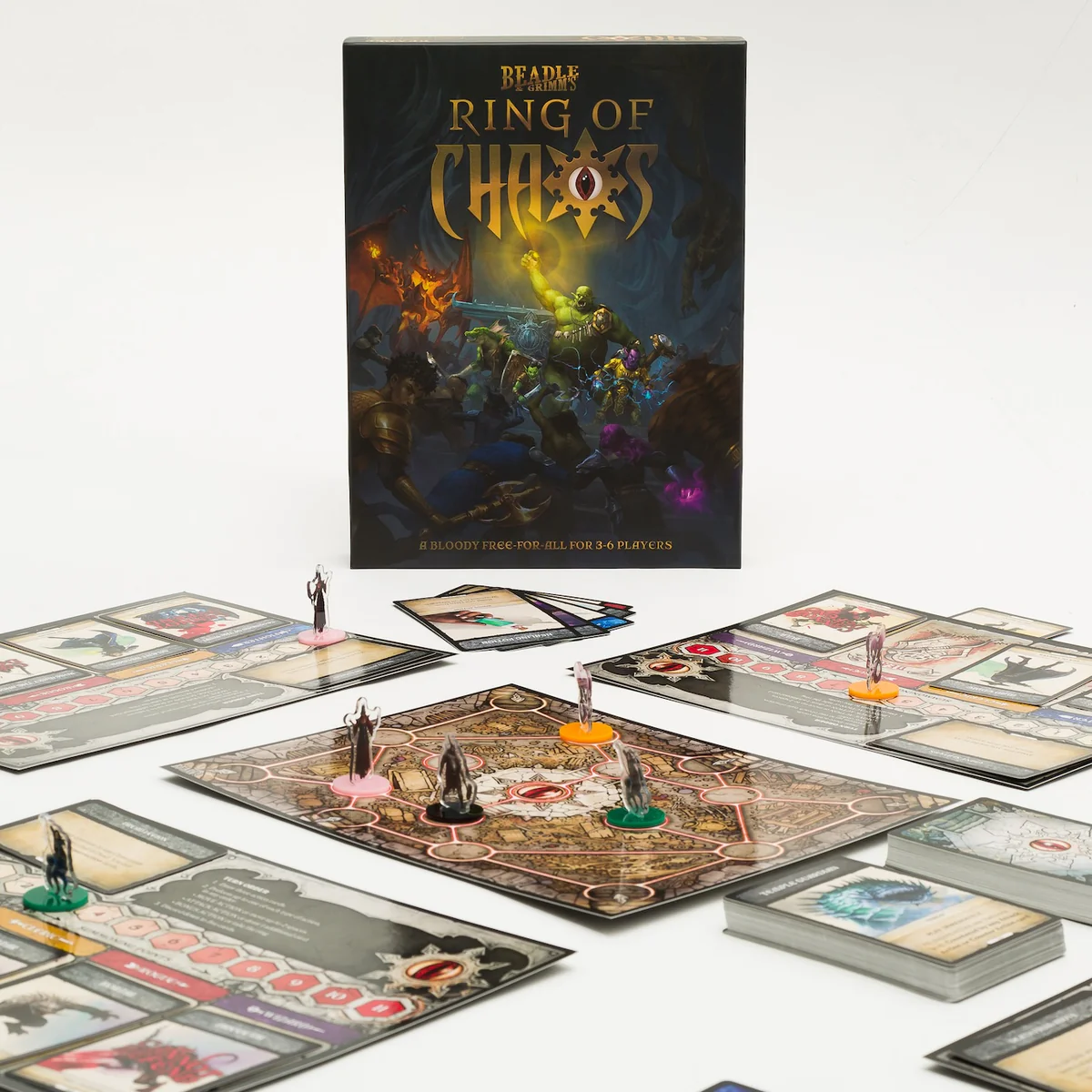Most tables of Dungeons and Dragons players are not keen to engage in PvP. But what if you could fight other player parties in a massive beat-em-up game of violence and fantasy action?
That’s the concept at the core of Ring of Chaos, the first ever board game developed and produced by Beadle And Grimm’s. B&G are best known by most players for producing unique versions of Magic the Gathering and D&D games for collectors, which often extend well beyond the contents of the books or cards themselves. Ring was initially funded on Kickstarter and released in the fall of 2024 to the public. But is this game printer actually able to make a board game that’s worthy of its name?
Note: A review copy of Ring of Chaos was provided to The Fandomentals for their review.

How to Play
Every player runs their own party of adventurers, complete with a fighter, a rogue, a wizard and a cleric. There are eight parties, each one presenting their unique designs and abilities. Perhaps your party is a necromancer and his undead posse. Perhaps it’s a bunch of dragons. Or maybe it’s a bunch of goblins, bugbears, and orcs known as the “Brute Squad.” You’re then dealt a hand of cards and must be prepared to brawl with your fellow adventurers.
The gameplay felt very similar to a D&D party, where you had a movement action, an attack action, and a bonus action. Players can either play cards that fit into one of the three action types or take appropriate actions as events go on. For example, a player could use a Sword card to hit an enemy party next to them, use a bonus action to steal the Ring if they have it, and then move several steps away. If the attack action hits, then it damages one of your four characters. If the character isn’t healed before being hit again, they die.
There are also reaction cards and temple guardian cards. Reactions can be used to block other player’s actions. Temple guardians, in contrast, are a random threat in the deck that will appear and affect nearly all players by attacking them.
The vast majority of cards are classless and can be used by anyone. But some do share colors with their classes and require the subsequent character from your party to be alive to use. For example, a player’s cleric must be alive for a Resurrection card to be used.
The goal was to eliminate all other players or gather enough points by holding the ring long enough.
Review:
The game’s designs are delightful, capturing a very action-oriented fantasy setting in its tokens, board, and card art. The board quality and cards were also nice, holding up to some duress. The player tokens in the version we received were character art printed on plastic tokens and were printed directly onto them. They appeared more durable than the 3D-printed miniatures of the platinum version, but it seems like the art on the token could easily be damaged if not handled appropriately. The ring was a nice piece of jewelry, albeit designed more for gameplay than actual wearing. The board has two sides, offering more variety and spots depending on how many players are involved.
Gameplay moved fairly quickly once I and my fellow players were familiar with how the game worked. There was a lot of similarity in how the action economy worked compared to your standard D&D game, which made embracing play easy. We went through about two to three rounds within two hours. The special abilities were unique enough to make each party feel different, but they rarely substantially impacted gameplay since other cards were often better options. I think I saw players use them once or twice over my period of test play.
The card descriptions and art were clear and crisp, making it easy to use them without much thought.
However, I found some issues with clarity around the game’s rules. For example, I struggled a bit with how temple guardian cards worked. Each temple guardian is supposed to damage each player unless they have an action card or appropriate reaction card. Does a single person have to play a card to cancel it out for all players, or does it only affect the damage you’re taking? I presumed the second, but the rules were unclear about it. We eventually reached a house ruling on the subject, but this was an area I think needed more clarification
Conclusion: I found Ring of Chaos an easy-to-share game that most fantasy-loving and TTRPG fans will enjoy. The game’s art and setting capture a grimdark fantasy energy that will remind players of their favorite dungeon dives and monster fights, while the mechanics will be easy to pick up for anyone who has played Dungeons and Dragons. The game may seem like it will be immensely complicated at first glance, but teaching the game doesn’t take long at all. I highly urge any player looking for a fantasy fix to consider picking this up.
Images Courtesy of Beadle & Grimm’s
Have strong thoughts about this piece you need to share? Or maybe there’s something else on your mind you’re wanting to talk about with fellow Fandomentals? Head on over to our Community server to join in the conversation!


